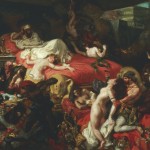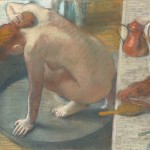Let’s just say it’s true, and that Edgar Degas and Edouard Manet—the two great granddaddies of Impressionism—did in fact meet when they bumped into each another while sketching a Velazquez at the Louvre. If not, it is still one of the better stories in modern art, as the inheritance of the line and the importance of outside influences from the arc of Parisian art history were absolutely essential in creating the revolution that laid the groundwork for abstraction, the 20th Century, and beyond.
And while their contemporaries often put down this work as amateurish and seemingly a mismatched assembly of pasted-on cutouts, years before Matisse, Degas especially remained steeped in tradition. As “Degas and the Nude” makes evident, the cutting edge Impressionist was indebted to his forebears and created new ground in drawing, sketching, and making pictures devoted to the craftsmanship and technique required when handling the line.
On view in Boston through February 5, 2012, “Degas and the Nude” examines the artist’s work within the broader context of his forebears, contemporaries, and followers in 19th Century France, among them Ingres, Delacroix, Cassatt, Caillebotte, Renoir, Toulouse-Lautrec, Matisse, and Picasso. This juxtaposition only serves to further highlight Degas as the modern master of the line, and in many ways the precursor to 20th Century attention to surface tension as evidenced by the Ab-Exers some 60 years later.
Paying special attention to the twist and curve of the model’s pose, and the intimate point-of-view that quite often casts his audience in a very specific role, there is a multi-layered discomfort to many of these works. From the uncomfortable tension of awkward poses, to the body’s relationship to surface space, the odd positioning serves to create an emotional tension as well. For an artist so remarkably proficient in technique, the straightforward depiction of lines, and masterful foreshortening, gives way to an incredibly ambiguous meditation on the relationships of art and culture, women and men, and divided social classes.
An assemblage of 165 Paintings, Drawings, Pastels, Prints, and Sculpture which represents the first museum exhibition devoted exclusively to the extraordinary range of nudes by Edgar Degas, the exhibition shows the tension of a man both bucking convention and blazing new ground. Even his all-encompassing subject matter—the female nude—seems so traditional in relation to his contemporaries. Yet “Degas and the Nude” reveals a new direction for line and pose, surface tension and curve that goes beyond the trappings of classicism and the new technology of the camera. The show explores the lasting effects of this Impressionist and the essential role he played in creating new directions for art.
Images above are, Left to Right:
The Death of Sardanapalus, 1844
Eugène Delacroix (French, 1798–1863)
Oil on canvas
*Philadelphia Museum of Art: The Henry McIlhenny Collection in memory of Frances P. McIlhenny, 1986
*Image Courtesy of the Philadelphia Museum of Art
*Courtesy, Museum of Fine Arts, Boston
The Tub, 1886
Edgar Degas (French, 1834–1917)
Pastel
*Paris, Musée d’Orsay, bequest of comte Isaac de Camondo, 1911
*© Photo musée d’Orsay / rmn
*Courtesy, Museum of Fine Arts, Boston
The Moon and Earth (Hina Tefatou), 1893
Paul Gauguin (French, 1848–1903)
Oil on burlap
*The Museum of Modern Art, New York. Lillie P. Bliss Collection, 1934
*© The Museum of Modern Art/Licensed by SCALA / Art Resource, NY
*Courtesy, Museum of Fine Arts, Boston




[…] http://artsamerica.org/blog/genre/art-museums/degas-and-the-nude-at-the-mfa/#anchor Share this:Like this:LikeBe the first to like this post. […]